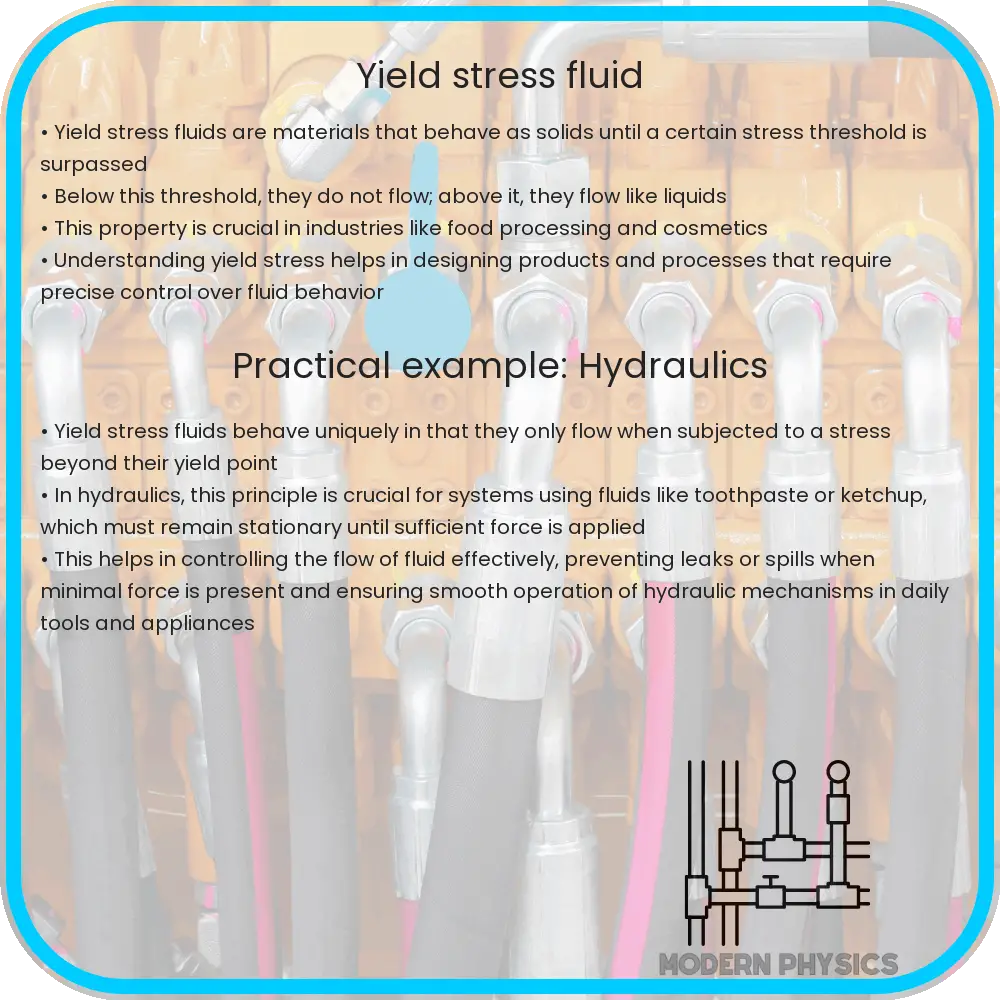Explore how yield stress fluids uniquely behave as both solids and liquids, adapting their characteristics based on applied stress, crucial in various industries.

Understanding Yield Stress Fluids: Viscosity and Hydrodynamics
Yield stress fluids are a fascinating category of materials that behave both like solids and liquids under different conditions. This dual nature makes them particularly interesting and useful in various engineering and scientific applications. In this article, we’ll explore the concepts of yield stress, viscosity, and their implications in hydrodynamics.
What is Yield Stress?
Yield stress is the minimum stress that must be applied to a material before it begins to flow like a liquid. Below this stress, the material behaves like a solid and maintains its shape. This property is crucial in industries where materials must be strong enough to hold their form under low stresses but flow under high stress, such as toothpaste, which must stay in the tube but flow when squeezed.
Viscosity in Yield Stress Fluids
Viscosity is a measure of a fluid’s resistance to gradual deformation by shear stress or tensile stress. For yield stress fluids, the viscosity isn’t a fixed number but depends on the stress applied to the fluid. Below the yield stress, the viscosity can be considered infinite, as the fluid behaves as a solid and does not flow. Once the yield stress is exceeded, the material flows and the viscosity can then be measured.
Modeling Yield Stress and Viscosity
One of the most common models to describe yield stress fluids is the Herschel-Bulkley model, which extends the Newtonian model of fluid dynamics. The equation for this model is:
\[ \tau = \tau_{y} + K \cdot \dot{\gamma}^{n} \]
where:
- \(\tau\) is the shear stress,
- \(\tau_{y}\) is the yield stress,
- \(K\) is the consistency index (a measure of viscosity),
- \(\dot{\gamma}\) is the shear rate, and
- \(n\) is the flow index.
This model shows that when the shear stress (\(\tau\)) is below the yield stress (\(\tau_{y}\)), no flow occurs. However, once the shear stress exceeds the yield stress, the fluid starts to behave more like a traditional fluid, with characteristics dependent on \(K\) and \(n\).
Hydrodynamics of Yield Stress Fluids
In hydrodynamics, the flow and behavior of fluids are analyzed, typically focusing on liquids. The study of yield stress fluids in hydrodynamics is particularly challenging due to their complex behavior. Here, not only the viscosity changes with stress, but the transition from solid-like to fluid-like behavior must also be addressed.
Understanding the flow dynamics of these fluids requires analyzing flow patterns, pressure drops, and force distributions within the fluid under varying conditions of applied stress. This analysis often utilizes sophisticated computational fluid dynamics (CFD) tools to simulate how these fluids behave in different engineering applications, such as in pipelines, processing equipment, and natural geological formations.
Common challenges in handling these materials include predicting plug flow regions where the fluid behaves as a solid and understanding the impact of these regions on overall fluid movement. These aspects are crucial for effective application and processing of yield stress fluids in industrial settings.
Whether optimizing the formulation of consumer products like cosmetics and food or improving the efficiency of cement and industrial slurries, understanding the principles of yield stress and viscosity provides a foundation for innovation and problem-solving in fluid dynamics.
Applications of Yield Stress Fluids in Engineering
Yield stress fluids have diverse applications across various industries due to their unique properties. In the construction industry, for instance, concrete can be considered a yield stress fluid. Its ability to flow under the stress of pouring, yet maintain shape once in place, is crucial for building structures. Similarly, in the oil and gas industry, drilling muds exhibit yield stress characteristics to carry solid particles when flowing, yet hold them stationary under static conditions, preventing sedimentation.
In the consumer goods sector, yield stress fluids are integral in formulating products like ketchup, which must rest motionless in the bottle but flow easily when the bottle is squeezed. This duality ensures both convenience and minimizes waste.
Future Prospects and Innovations
Research continues to enhance the understanding and utility of yield stress fluids. Innovations in material science and fluid mechanics are likely to produce new formulations with optimized properties for specific applications. Additionally, environmental considerations are pushing for the development of yield stress fluids that are more sustainable and less harmful in their lifecycle.
One potential area of growth involves smart fluids, which respond dynamically to external stimuli such as magnetic fields or electric currents. These could lead to revolutionizing how we use fluids in technology, potentially creating more efficient and adaptive systems in industries ranging from automotive to healthcare.
Conclusion
Yield stress fluids present a fascinating interplay of solid-like and liquid-like behaviors that pose both challenges and opportunities. Understanding their properties such as viscosity and yield stress, and effectively modeling their behaviors using frameworks like the Herschel-Bulkley model, enables engineers to manipulate these materials for practical use, from everyday products to complex industrial systems. As we continue to explore the boundaries and applications of these materials, their role in advancing technology and improving our daily lives becomes increasingly apparent. Embracing both the complexity and potential of yield stress fluids will likely yield significant advancements in both science and engineering fields.
